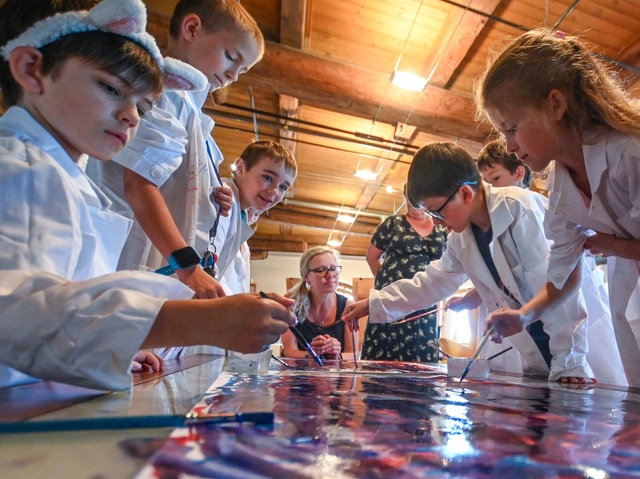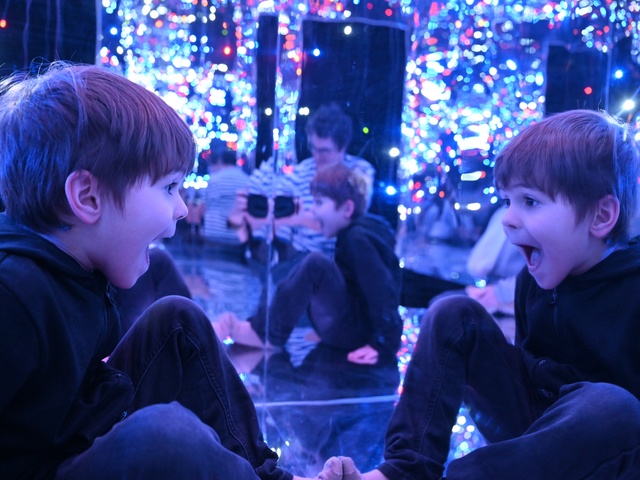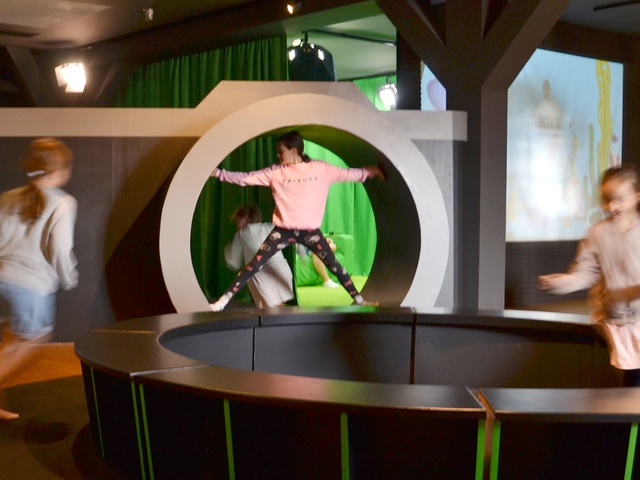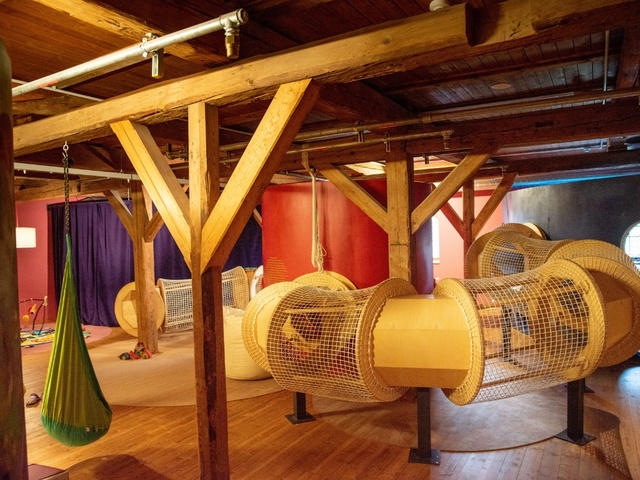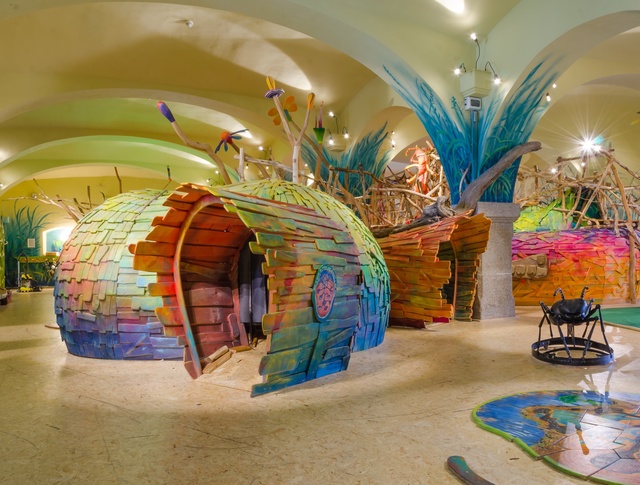
The Anthill: Do you know the best way to learn about the life of ants? It’s simple: just become one of them / Photo: Petr Brůha
Sladovna means malt house
Sladovna Písek, with its concept of the “Gallery to Play”, is a relatively new institution. It has been operating in the field of children’s institutions since 2012. During this time, it has gone through quite a rich journey, full of experiments, inspiration, and cooperation. Today, it is perceived as an established institution with a stable team that brings a fresh wind to the world of children's museum and galleries. Its key strengths include its interdisciplinary work, the strong role of a lecturer/guide, its orientation towards child visitors, the interconnecting of art and education, its participatory labs where children (and their adults) become co-authors of exhibitions and the programme, as well as the concept of art residencies for children and their adults. Sladovna also successfully collaborates with a number of renowned international partners. Sladovna's work can be considered as quite unique in the Czech environment.
Vision of Sladovna Písek, o.p.s.
Sladovna Písek is on a journey to create a new form of a living cultural centre where values are formed and conveyed to visitors of all ages. We cultivate quality professional culture – in the name of anchoring value systems, ethics, and social integrity – while making sure that culture is comprehensible to the general public. We aim to connect tradition with the present, art with everyday life, and the city of Písek with the world through stories, images, and play. Interaction and play represent the main instruments for teaching, learning, connecting, inspiring, and sharing the joy of life. Sladovna strives to be a space for visitors where culture and art become a natural part of every family’s everyday life.
Gallery to Play
The dramaturgy of Sladovna Písek revolves around the main programme concept of the “Playful Gallery”. It combines the theme of book illustrations with what is crucial for the development of any child – “play”.
The “Playful Gallery” is a space where adults and children play and create together, where they learn from one another, and where it is possible to freely cross between the boundaries of the adult and children’s worlds. The work of the lecturers in the exhibitions is crucial, and we find inspiration in the approach of J. A. Comenius.
For a long time, Sladovna was used for the production of malt. The grains that arrived here started their journey in the malt house, this first step being very important for its future. Today, children arrive in Sladovna, and we believe that their experience will “sprout” in them and help them in their growth and development.
The large malt house building offers permanent and temporary exhibitions on seven floors, which provide a lot of inspiration, creativity, experiences, and learning through play. Therefore, it is possible to come back repeatedly and always discover something new.
The basic principle of the exhibitions is simple. Children and their adults leave the real world behind for a while and enter a story in which they find themselves in many situations. They have to be active, help one another, make decisions, and be responsible for their behaviour. We believe that this experience lingers after they leave the exhibitions and go back to the real world, helping them in their learning and development.
The future of museums and their roles
I hope that children's museums will play an important role in finding the right approach to children's development in the education system and in experimenting and testing such approaches. The future is very difficult to predict. However, I would like children's museums to be real homes for kids, teachers, and adults. Places where you and your children – through culture, arts, and play – can learn how to create positive change for the future. I feel their role should be to help and prepare children for the future, to help open up new learning opportunities for school systems, and to contribute to the shaping of a better future. That is why I think we need to learn from each other, provide feedback, and inspire each other, while at the same time providing children with more and more opportunities to be part of the whole process of shaping the children's museums’ programmes. We need to be open to new generations of young people and respond to them with respect and openness.
Children and their role in museums
Personally, I believe that children will (and probably already do) play a big role in the museum industry. The world is changing in a dynamic way, so it is very difficult to prepare new generations of young people for their future when we do not know what it will be like and what will be needed. Therefore, I think it is crucial to involve children in the creation of exhibitions, in the search for answers to basic questions, and maybe even in the search for questions that they find important. I really like working with children at Sladovna, and I like the Labs project, where children become co-authors of exhibitions. When we work together, I learn a lot from them, and they often surprise me with their confidence regarding certain topics and attitudes. I think we should create an environment for children where they can create freely, learn from each other, and think about how to face different problems and situations. Children are the future; their role is the most important one.
I love to hand the initiative to the children, to let them think about the particular issue or topic, and I am always surprised that they are able to face the issues, often better than adults. It also seems to me that it is possible to transform the approach to education in children's institutions; we call this role the mediator, the “guardian of the experience”, who ideally knows different ways of guiding the programme and mediating the relationship not only between the visitor and the exhibition, and the artist and the public, but also between the visitors themselves. Depending on the particular group of visitors to whom the mediator is trying to tune in, s/he composes the experience that s/he feels is the most suitable for that particular group, while always trying to aim for a given goal/outcome/experience.
We are quite free in choosing the topics of exhibitions at Sladovna. We always try to respond to current events, i.e., what we think society needs now. At the same time, dialogues with children and experience gained during the process of working directly with children are crucial to us.
For example, we are currently preparing the “Laboratory of the Idea”, which is based on an artistic residency of nine artists or teachers from different countries and the Sladovna team. In fact, the idea originally came from my daughter Antonia, who wished to have a laboratory for her ideas. It will probably be an empty room where children and their adults will enter with an idea and have the opportunity to experience the creative process to find out how an idea is born, what it takes to make it happen, etc. It is actually about letting children be a part of the process of creating an exhibition right from the very beginning: from a stage when the theme and the goal have not yet been decided. I am really enjoying this project, and I somehow feel it will be a very important experience for me and for my colleagues. And who knows, maybe it will eventually turn into an exhibition that the children themselves will create.
Digital world
The use of digital technology in exhibitions and programmes for children is always a big topic for me and the Sladovna team. This topic has already been the focus of the Hands On! conference we hosted in 2017. Covid added a new and distinctive perspective. In one Creative Europe project, we had to develop some online programme formats right after the pandemic started, and it was an important experience. At the same time, I have to say that I personally prefer the physical experience, and we tend to show children and their adults how they can enjoy something extraordinary with their own bodies, and the offline experience can be deeper. In Animarium (Animation studio) and other projects, we have dealt a lot with the extent of the use of technology, finding that it is always a bit dangerous to be so-called “drunk on technology”. That is, we try to use technology for a specific purpose, and we kind of hide it. In Animarium, the use of technology is addressed directly as a topic for education. That is not to say that I am somehow condemning the digital world and the online environment; I think it is a great help, but we just need to look for the right balance and correct ways to use it.
Finding new ways
In order to find new ways to educate children and prepare them for the future, we need to listen to them and involve them in the process. I consider it equally important as the collaboration with colleagues from different countries, the exchange of experiences, learning from each other, and inspiring and supporting each other. This is the role of the Hands On! association, and I personally would like to see more cooperation between institutions. At Sladovna, we are grateful for all the past and ongoing projects with foreign and local partners, because they have always brought something new. For example, together with the Viennese children's museum ZOOM, we created Animarium, an animation studio. ZOOM improved their concept and upgraded the studio after its twenty years of existence. I think that the joint exchange of experiences and ideas, as well as a look under the hood of the functioning of individuals and the whole institution, has taken us a huge step further, and apart from the friendships that have been formed, both institutions have learned a lot. We have also worked closely with the MUBA Museum in Milan, where, together with the Romanian association DaDeCe, we were working on a programme for perhaps the most difficult age group of teenagers. This year we were part of Festival der Regionen festival, and we are in contact with many others such as Frida and Fred Graz. We are also part of international projects such as LOODA, Tomato, and Re-Value. We also managed to take the Drak Theatre exhibition to Maribor, Slovenia, which made me really happy since it required testing the concept on foreign visitors, which is always enriching and valuable. In short, we are always learning something new, and we need it.
I think that nowadays, apart from the traditional countries where children's museums are being developed, very distinctive and original activities and institutions can also be found in post-communist countries. Both sides benefit greatly from the mutual cooperation.
What I also consider very valuable is the Hands On! Home of the 21st Century Education certification, which consists of eight criteria that, in my opinion, are very important for the current times and for children themselves. These define the standards that such institutions should meet, and I identify with them:
- Children's door to culture: easily accessible public place of joy, beauty, and imagination
- Home of interactive self-learning: trying out the unknown, astonishment, and imagination. Learning through play!
- Developing children's talents holistically as a meaningful experience for all senses
- Children as an equal part of society, imagining and changing the world into a better place
- For all ages, bridging the gaps between generations
- Place to interact and engage, no matter who you are. Every voice can be heard
- Navigating between reality and virtuality, for children and adults, digitally aware and active
- Connecting to global issues but acting locally. Constantly responding to what is needed
I like the abstract mythological vision of what children’s galleries or museums could be: “Children’s museums or galleries are places for explorers (visitors), who are coming there to meet with a magician (female). They are coming there with questions. The magician is giving them the experience, the possibility to go to the mythopoeic world, and gain there the experience and possibility to compare the real world with the mythopoeic one (history, future, story, nature, technologies, etc.) and thus verify their question. The magician is there to keep the light that can help them find the right answer (she is not giving the answer, she is giving the light). When leaving the cave, visitors are aware that their question is the “right question” for them, and they are quite sure which way to go to look for the right answer.
Credits und Zusatzinfos:
Permanent Link: www.doi.org/10.58865/13.14/234/4
Zitat:
Adam Langer: Sladovna means malt house, in: neues museum 23/4, www.doi.org/10.58865/13.14/234/4.
Permanent Link: www.doi.org/10.58865/13.14/234/4
Zitat:
Adam Langer: Sladovna means malt house, in: neues museum 23/4, www.doi.org/10.58865/13.14/234/4.
